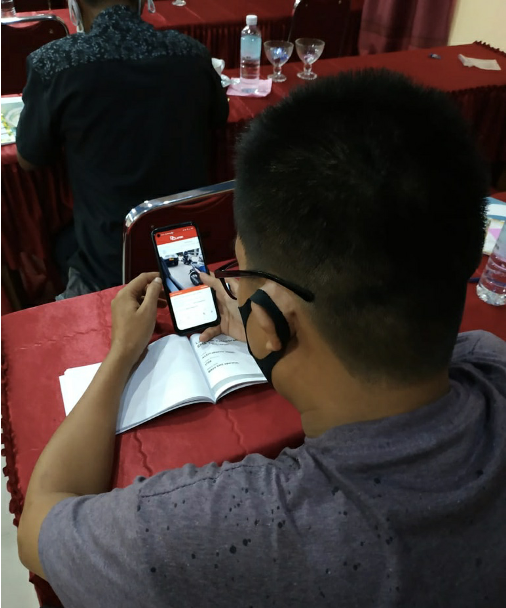
One of the essential components in achieving social accountability, especially in the mining sector, is public participation. After months of mapping, community issues around the mining sites, namely GPSA regional partner, GeRAK ACEH in Aceh Province, Pokja-30 in East Kalimantan Province, and LePMIL in Southeast Sulawesi Province, the lack of information regarding the complaint mechanism is one of the concerning problems.
The Mining Sector Social Accountability Project aims to improve the management and governance of the mining sector, including encouraging public participation through a responsive complaint platform. After conducting the research and testing several complaint channels, Lapor 1708 and ESDM 136 were considered more effective and responsive for community members. Therefore, in June, PWYP Indonesia collaborates with Awrago, a public communication consultant, and Civil Society Organizations (CSO) at each participating region, held the training for the use of complaints tools (ICT tools) in a hybrid way (online and offline) – as part of new normal adaptation from the COVID-19 pandemic situation – in the three communities that are located at closest proximity or ring one of the mining sites.
The three communities are representatives of Sungai Payang Village residents, Kutai Kartanegara (East Kalimantan), five villages in Seunagan District, Nagan Raya (Aceh), and residents of Lasolo Islands District, North Konawe (Southeast Sulawesi). The representatives consist of various elements of society, including women’s groups, traditional leaders, village leaders, and youth.
The Sungai Payang Village Community is the first to run the training on June 12, 2021. Around 30 people gathered in the hall of a hotel in Kutai Kartanegara, which was quite a distance from Sungai Payang. Each of the participants brought issues to their villages, generally concerning the river pollution caused by mining factory waste to job opportunity transparency from companies and the goal of getting a better understanding of the use of SP4N LAPOR! complaint platform 1708 (lapor.go.id) and ESDM Contact Center 136.
On June 19, 2021, the residents of Seunagan Subdistrict, Nagan Raya, in Aceh, received the training. Initially, the training must face several problems due to cancellation from some of the participants. Despite that, the remaining participating attendees remained enthusiastic. Mining management issues in Seunagan are generally related to the distance of mining activity sites within the residential area and the low absorption of local workers.
On June 26, 2021, community members of Lasolo Islands Sub-district, North Konawe, came from across the island to the hall at the hotel in the district capital to attend the training on complaint channels of mining governance.
Each regional partner CSOs act as facilitators on the training as previously they have been provided with the materials through Trainer of Trainers (ToT) to make sure the facilitators understood the materials better based on the context and reality in their respective regions, which will ensure the training runs well and better prepared to lead the training to the residents.
Training Agenda: Understanding Problems to Complaint Simulation
Before introducing the LAPOR! 1708 and ESDM Call Center 136 platforms, it is essential for the community to understand the issues and causes, which was the first training material called fishbone diagrams. This diagram is also known as the cause-and-effect diagram, which traces the cause of the problem. The head indicates the problem/effect, while the spine and soft bones are possible causes. The shape of this fishbone relates closely to people’s daily lives, especially in coastal and river areas, so it is expected to be readily accepted and understood.
Participants directly practice the fishbone diagram with the issues they face at respective villages. In this session, participants were given a black fishbone diagram to be filled with their own experiences. The participants’ enthusiasm created a two-way discussion with active participation. The national-level facilitator, Awrago, provided constructive feedback to residents in compiling fishbone diagrams in order for the residents to better understand the difference between the impact and consequences of a particular issue.

On simulating complaints using the Lapor application, the participants are communicating both ways excellently. For instance, National Facilitators corrected the choice of agencies/institutions to report to for the clean water crisis in their village. The residents initially chose the Public Works and Housing Ministry, while the facilitator suggested the correct institution is Energy and Mineral Resources Ministry and Environment and Forestry Ministry, which were deemed more relevant to the content of the complaint. In the last part of the simulation, facilitators told the residents not to worry about the institutions to complain to since the system will adjust accordingly.
After better understanding the issues and possible causes through a fishbone diagram, LAPOR! 1708 and ESDM 136 were introduced as the right of every citizen for access to information and guaranteed by Law no. 14 the year 2008, Law no. 25 of 2009, as well as the Government of Indonesia’s commitment to the Electronic-Based Government System, complaint services, features and advantages of the two complaint channels, and to practice reporting directly. This regulatory information is expected to become the basis for the understanding of citizens to participate and carry out supervision through complaints to improve the mining governance.
The feedback from the training is observable through the pre-training and post-training surveys. The pre-training surveys were conducted to understand the community’s understanding of the complaints channels and access to communication technology. Before the training, most participants were not aware of the existence of a complaint channel like LAPOR! 1708 and ESDM 136. After the training, 97% of participants understand how to report appropriately through the complaint services like LAPOR 1708 and ESDM 136.
The training on the use of ICT tools for mining governance complaints does not stop there; besides educating the public, the organizers also carry out a follow-up on community reports.